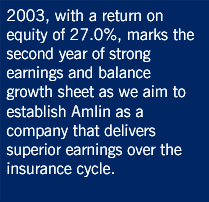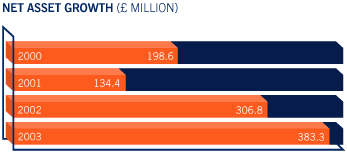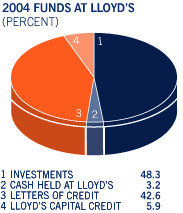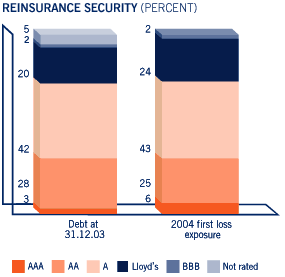|
 |
|
|
 |
|
|
 |
 |
 |
|
FINANCIAL STRENGTH
In 2003 net assets grew by 25% to £383.3 million.
Notwithstanding the increased Funds at Lloyd’s requirement
of £432.6 million, to support the £138 million increase in
our aligned underwriting for 2004, gearing (including off
balance sheet letter of credit finance) remained stable
at 50% of shareholder equity.

A key feature of our capital management has been the use
of debt finance to support our underwriting.
The diversity of our business and its profitability at, and towards the
peak of the cycle, makes the use of Letters of Credit or debt finance
to support our underwriting an attractive alternative. Simply it should
enhance return on equity without overly exposing equity capital
to inordinate risk. Moreover, with our strategy of increasing
or decreasing capacity according to margin potential, it provides
a flexibility which helps enhance return on equity over the cycle.

The level of gearing should be considered taking account of Lloyd’s
three year accounting that limits the release of profits that can be
used as solvency capital until closure of a year of account. Were
Amlin able to use the earned proportion of 2001 to 2003 Lloyd’s
year of account profits in place of debt finance, as would a typical
insurance company, its gearing level would be reduced to 28.5%,
at 31 December 2003.
The capital regime is about to change. From 1 January 2005 we
expect to be operating under a new FSA risk based capital regime.
This is currently under consultation. The risk based capital regime
that Lloyd’s operates will still be a part of the regulatory
landscape. However, we expect in future to be able to recognise
for regulatory purposes all of our accrued profit, on an annually
accounted basis. At present only limited credit is given for this
undistributed profit from years that have not ‘closed’ at Lloyd’s.
Back to top
Reinsurance security
The purchase of reinsurance protection is an essential part of our
risk management, through the containment of exposure against
our capital from single claims and the aggregation of claims from
catastrophic events.
We place our reinsurance with companies that we believe are
financially and operationally strong. Our evaluation considers
financial strength, trading record, outlook and organisational
structures. Our information is drawn from a number of sources:
public information produced by the company, our own experience
with the reinsurer and our knowledge of their behaviour in the
market place, analysis from a reinsurance consultant and rating
agency commentary and gradings.

Reserving
During the last few years we have witnessed significant
deterioration of reserves for many companies in the industry.
This clearly illustrates that the financial strength of an insurance
company is as much about the quality of its balance sheet as the
quantity of reported assets.
At Amlin we attempt to limit the risk of adverse development in
two ways. First, we have concentrated our underwriting on short tail
classes of business, reducing the inherent uncertainty of reserving
over the medium term. Second, we adopt what we believe to be a
prudent reserving stance. We aim to set our reserves so that there
is a greater prospect of surplus which can be released in the future.
This is illustrated by the £24.5 million release in 2003.
|
|
|
|
|
|